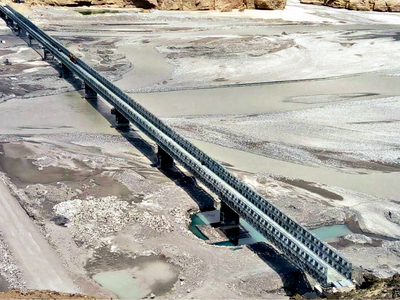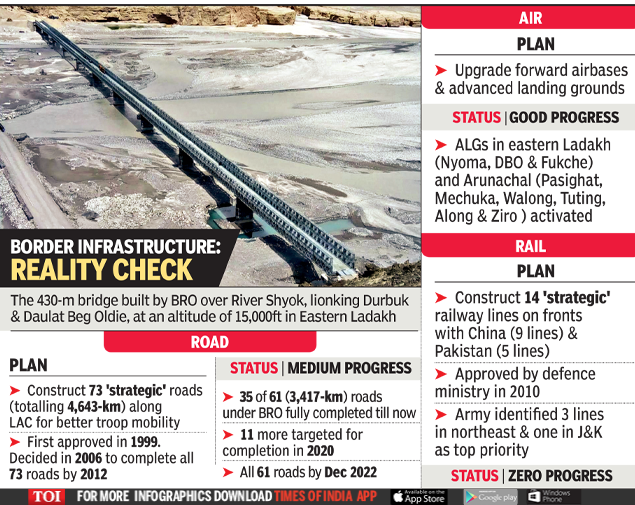
India’s LAC infra upgrade unnerves China
by Rajat PanditThe 430-m bridge built by BRO over River Shyok, linking Durbuk & Daulat Bag Oldie, at an altitude of 15,000 ft...Read More
NEW DELHI: With the tiger no longer crouching, and in fact getting more capable of leaping out of the trenches now, the dragon obviously is breathing fire. China has been unnerved by India’s slow but steady improvement in border infrastructure for faster mobility of its troops and weapon systems in forward areas over the last few years.
India may still have a long way to go in matching China’s border infrastructure, leave alone the stark asymmetry in terms of military forces and capabilities, but is now increasingly challenging the dragon’s dominance in road and air connectivity in disputed high-altitude stretches along the 3,488-km Line of Actual Control (LAC) from Ladakh to Arunachal Pradesh. This has certainly irked China. One of the triggers for the ongoing troop confrontations in eastern Ladakh, for instance, is India’s completion of the 255-km Darbuk-Shyok-Daulat Beg Oldie (DBO) road last year and its fresh move to build some additional feeder link roads and bridges.

Read also: India firm, won’t step back from areas where Chinese troops have intruded
The DSDBO road, which has 37 bridges, runs almost parallel to the LAC to provide easier access to the Depsang and Galwan Valley areas while ending near the strategically-important Karako ram Pass. It is linked at several places to troop and logistics bases in depth areas. “The People’s Liberation Army (PLA) is upset that some of our roads now provide swifter induction of troops in border regions of Ladakh. With better infrastructure on both sides, there will of course be more incidents of rival troops coming face-to-face,” said a senior officer. But the overall situation along the LAC is still far from adequate. Only 35 of the 73 “strategic’’ all-weather roads, with more east-west lateral links as well as better access routes to strategic peaks and valleys, identified for construction almost two decades ago, have been fully completed till now.
China's Xi urges preparedness for military combat amid coronavirus epidemic
“In eastern Arunachal, for instance, most road heads are around 20 to 70 km away from the LAC. Our patrols have to trudge for miles to physically dominate our claim lines. The PLA has no such problems,” he added. But India has certainly sent an unmistakable strategic signal to China by re-activating and upgrading old advance landing grounds (ALGs) in both eastern Ladakh (Nyoma, DBO and Fukche) and Arunachal (Pasighat, Mechuka, Walong, Tuting, Along and Ziro ) over the last decade. The landings of C-17 Globemaster-III and C-130J “Super Hercules” aircraft at these makeshift airstrips allows India to move troops and equipment to
“threatened areas” along the LAC much more quickly now.
The ALG at DBO, the highest such airstrip in the world at an altitude of 16,614-feet, for instance, overlooks the strategic Karakoram Pass and is just a few kilometres away from the LAC and the Chinaoccupied Aksai Chin region beyond. China has assiduously built an extensive military infrastructure in the Tibet Autonomous Region, which includes 14 airbases, an extensive rail network and over 58,000-km of roads. China is now also constructing underground hangers and parking bays for its fighters by digging tunnels into mountains at some of the airbases, as was reported by TOI earlier.
In Video:India-China standoff: Top Army commanders meet to review security situation